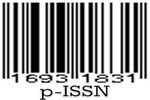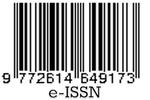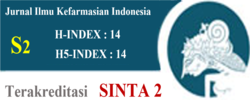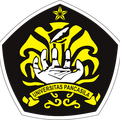Isolation and Characterization of Agarose from Gracilaria verrucosa Seaweeds
Abstract
: Agar is complex polysaccharide which could be isolated from group Rhodophyta of seaweeds, sucs as Gracilaria verrucosa. Agar consists of two components, namely agarose and agaropectin. Agarose is neutral polysaccharide, while agaropectin is polysaccharide that contain sulphate, so agarose could be used for gel electrophoresis. The use of NaOH solution was aimed to hydrolyzes the agar to form 3,6-anhydro-L-galactose, whereas the use of propylene glycol was to separates agarose from agaropectin. This research was aimed to isolate agarosa from Gracilaria verrucosa using NaOH solution with the concentrations of 4%, 6%, 8%, 10% and propylene glycol of 30, 50 and 70 mL. The agarose obtained was giving specivic absorbtion band in IR spectrum with wave number in the region of 930 and 890 cm-1, and there were absorbtion band in the region of 860 and 830 cm-1, indicated that the agarose still contained sulphate. The increase of NaOH concentration and propylene glycol volume caused drawback sulphate and ash content, constant melted temperature and gel temperature but increase gel strength. The best amount of agarose was obtained with the use of NaOH 10% and 70 mL of propylene glycol, with the characteristics were: ash content of 2.0035±0.0429% (w/w), sulphate content of 0.3236±0.0131% (w/w), melted temperature of 34 oC, gel temperature of 90 oC, gel strength of 432.195±26.172 g/cm2 and degree of electroendosmosis of 0.20±0.005.
References
2. Anggadiredja JT, Zatnika A, Purwoto H, Istini S. Rumput Laut. Jakarta: Penebar Swadaya; 2010.
3. Fransiska D, Murdinah. Prospek produksi agarosa dan agar mikrobiologi di Indonsia. Jurnal Squalen. 2007. 2(2): 65-72.
4. Wang TP, Chang LL, Chang SN, Wang EC, Hwang LC, Chen YH, et al. Successful preparation and characterization of biotechnological grade agarose from indigenous Gelidium amansii of Taiwan. Process Biochemistry. 2012. 47.
5. Chapman V J. Seaweeds and Their Uses. Second Edition. The Camelot Press. London and Southampton. 1970. p. 187, 188.
6. Cook RB, Witt HJ. Agarose composition, aqueous gel and method of making same. United Stated Patent. 1981. No. Patent 4,290,911.
7. Rebello J, Ohno M, Ukeda H, Kusunose H, Sawamura M. 3,6 anhydrogalactose, sulphate and methoxyl contents of commercial Agarophytes from different geographical origins. Journal of Applied Phycology. 1997. (9): 367-70.
8. Purwoto H, Gustini S, Istini S. Pemurnian agarosa dari agar-agar dengan menggunakan propilen glikol. Dasar-dasar Tehnik Kimia. Peningkatan Daya Saing Nasional Melalui Pemanfaatan Sumber Daya Alam untuk Pengembangan Produk dan Energi Alternatif. 2000. 1- 5.
9. Lahaye M, Rochas C. Chemical structure and physico- chemical properties of agar. Hydrobiologia 221. International Workshop on Gelidium. 1991. p. 137-48. 10. Provonchee RB. Agarose purification method using glycol. United Stated Patent. 1991. No. 4,990,611.
11. Horwitz W. Official methods of analysis of AOAC Internataional. 17th Edition. Volume II. Agricultural Chemical. Contaminants, Drugs, Baking Powder and Baking Chemicals. 2000. 5.
12. Kumar V, Fotedar R. Agar extraction process for Gracilaria cliftonii. Carbohydrate Polymers. 2009. (78): 813-9.
13. Depkes RI. Farmakope Indonesia. Edisi IV. Jakarta: Departemen Kesehatan Republik Indonesia; 1995.
14. Pelegrin YF, Robledo D. Influence of alkali treatment on agar from Gracilaria cornea from Yucatan, Mexico. Juornal of Applied Phycology. 1997. (9): 533-9.
15. Kalesh NS. Phycocemical distinctiveness of selected marine Macrophytes of Kerala Coast [thesis]. Cochin University of Science and Technology. Departement of Chemical Oceanography. 2003. 28, 332.
16. Distantina S, Anggraeni DR, Fitri LE. Pengaruh konsentrasi dan jenis larutan perendaman terhadap kecepatan ekstraksi dan sifat gel agar-agar dari rumput laut Gracilaria verrucosa. Jurnal Rekayasa Proses. 2008. 2(1): 11-6.
17. Pelegrin YF, Murano E. Agars from three species of Gracilaria (Rhodophyta) from Yucatan Peninsula. Journal Bioresource Technology 2005. 95: 295-302.
18. Pavia DL, Lampman GM, Kriz GS, Vyvyan JR. Introduction to spectroscopy. 4th Ed. USA: Brooks/ Cole Cengage Learning; 2001. 16-7.
19. Nazaruddin MF, Shamsuri AA, Shamsudin MN. Physicochemical characterization of chitosan/agar blend gel beads prepared via the interphase method with different drying techniques. Int J Pure Appl Sci Technol. 2011. 3(1): 35-43.
20. Mollet JC, Rahaoui A, Lemoine Y. Yield, chemical composition and gel strength of agarocolloids of Gracilaria gracilis, Gracilariopsis longissima and the newly reported Gracilaria cf. vermiculophylla from Roscoff (Brittany, France). Journal of Applied Phycology. 1998. 10: 59-66.
21. Pereira L, Sousa A, Coelha H, Amado AM, Claro PJAR. Use of FTIR, FT-Raman and 13C-NMR spectroscopy for identification of some seaweed phycocolloids. Biomolecular Engineering. 2003. 20: 223-8.
22. Balkan G, Coban B, Guven KC. Fractionation of agarose and Gracilaria verrucosa agar and comparison of their IR spectra with different agar. Acta Pharmaceutica. 2005.
23. Praiboon J, Chirapart A, Akakobe Y, Bhumibhaman O, Kajiwara T. Physical and chemical characterization of agar polysaccharides extracted from the Thai and Japanese Species of Gracilaria. Science Asia 32 Supplement. 2006. (1): 11-7.
24. Montano NE, Villanueva RD, Jumelita B. Chemical characteristics and gelling properties of agar from two Philippine Gracilaria spp. (Gracilariales, Rhodophyta) Journal of Applied Phycology. 1999. (11): 27-34.
25. Masak PRP, Rosmiati. Performansi pertumbuhan dan kandungan agar rumput laut Glacillaria verrucosa dengan sumber bibit dari lokasi berbeda di Sulawesi Selatan. Prosiding Seminar Nasional Kelautan V. Universitas Hang Tuah Surabaya. 2009: 280-4.
26. Sahabuddin, Sahrijannah A. Kualitas agar rumput laut Gracilaria verrucosa pada tambak polikultur dengan waktu kultur berbeda. Prosiding Seminar Nasional Kelautan VI. Universitas Hang Tuah Surabaya. 2010: 271-6.
27. Anonim. Agarose N. Amersham Biosciences. Data File Submarine System. 2008.
28. Laurienzo P. Marine polysaccharides in pharmaceutical applications: An Overview. Marine Drugs. 2010. (8): 2435-65.
29. Warren KA. Comparative study of the electrophoretic efficiencies of the Invitrogen E-Gel® Pre-cast Agarose Electrophoresis System, the Cambrex FlashGel™ System, and the GelRed™ Nucleic Acid Gel Stain. The Biology Departement of Saint Martin’s University. 2007.
Licencing
All articles in Jurnal Ilmu Kefarmasian Indonesia are an open-access article, distributed under the terms of the Creative Commons Attribution-NonCommercial-ShareAlike 4.0 International License which permits unrestricted non-commercial used, distribution and reproduction in any medium.
This licence applies to Author(s) and Public Reader means that the users mays :
- SHARE:
copy and redistribute the article in any medium or format - ADAPT:
remix, transform, and build upon the article (eg.: to produce a new research work and, possibly, a new publication) - ALIKE:
If you remix, transform, or build upon the article, you must distribute your contributions under the same license as the original. - NO ADDITIONAL RESTRICTIONS:
You may not apply legal terms or technological measures that legally restrict others from doing anything the license permits.
It does however mean that when you use it you must:
- ATTRIBUTION: You must give appropriate credit to both the Author(s) and the journal, provide a link to the license, and indicate if changes were made. You may do so in any reasonable manner, but not in any way that suggests the licensor endorses you or your use.
You may not:
- NONCOMMERCIAL: You may not use the article for commercial purposes.
This work is licensed under a Creative Commons Attribution-NonCommercial-ShareAlike 4.0 International License.

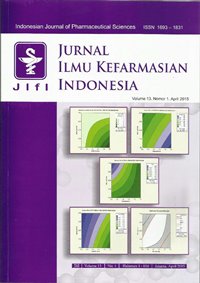



 Tools
Tools

